Fox Theatre
Introduction
Text-to-speech Audio
The Fox Theatre of St. Louis, located at 527 N. Grand Boulevard, was one of five spectacular Fox Film Corporation "picture palaces," designed for both film exhibition and stage shows, that the Corporation built at the end of the 1920s (the others were in Brooklyn, Atlanta, Detroit, and San Francisco). Opening for the first time on January 31, 1929, the theatre, nicknamed "The Fabulous Fox," was constructed by architect C. Howard Crane in a style incongruously known as "Siamese Byzantine," consisting of a mishmash of various exotic motifs. Seating 5060, it was reportedly the second largest theatre in America at that time.
However, the Fox Film Corporation fell on hard times during the Great Depression of the 1930s. Changing owners, the Fabulous Fox carried on with a combination of movies and concerts until forced to close in 1978, one year shy of its 50th anniversary. In 1981, an organization to restore the theatre, Fox Associates, began a one-year multi-million-dollar overhaul of the structure, restoring it as closely as possible to its original 1929 grandeur, but with modern sound, lighting and dressing rooms. It reopened on September 7, 1982, and remains in operation today as a venue for concerts and Broadway shows. In 1976, the Fox Theatre was included in the National Register of Historic Places.
Images
The marquee of the Fox Theatre - St. Louis
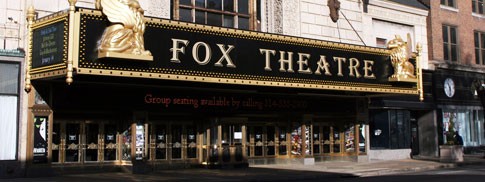
An Interior view of the Fox Theatre
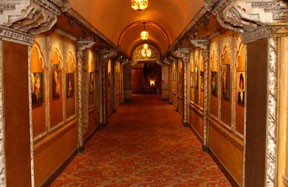
A view of the theatre from the stage
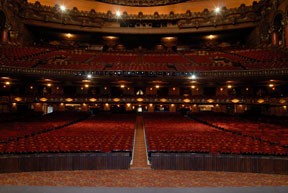
A detail of the design of the theatre
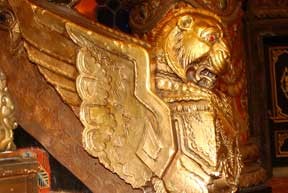
A detail of the design of the theatre
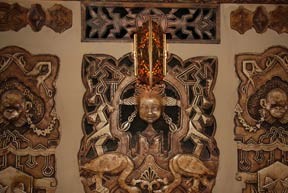
Backstory and Context
Text-to-speech Audio
William Fox, born Wilhelm Fuchs in 1879, arrived in America from Europe as the infant son of Jewish immigrant parents, and grew up on New York's Lower East Side. He started out in the fur trade in 1900, switched to the burgeoning movie business four years later, and founded Fox Film Corporation in 1915, which produced many popular pictures, including those of cowboy star Tom Mix. By the late 1920s, the Fox empire commanded a nationwide chain of 1100 theatres. Not content with that, in 1929 Fox opened five grand picture palaces of unprecedented size and opulence called the "Super Foxes," of which the St. Louis Fox Theatre was one. Unfortunately, that same year, 1929, saw William Fox's downfall. His attempt to take over MGM resulted in a long-running antitrust suit; he was involved in a near-fatal car accident; and the stock market crash inaugurated the Great Depression, miring Fox and his corporation in debt and essentially ending his career.
Construction began on the Fox Theatre in St. Louis in 1927, at the site of the defunct Grand Avenue Presbyterian Church. The Winkle Terra Cotta company constructed the facade. Architect C. Howard Crane, who had already built many classic movie palaces, designed the theatre in what was called the "Siamese-Byzantine" style. The interior, made of plaster, included Moorish, Far Eastern, Egyptian, Babylonian and Indian elements. (It has been suggested that the movie audiences of the day, because they was far less well-traveled than today's audiences, might not have recognized the incongruity of all these clashing styles.) Opening night was attended by many of the wealthiest citizens of St. Louis, and a newspaper reported, "Gov. Henry S. Caulfield dedicated the new $5,000,000 Fox Theatre last night before probably the most notable first-night crowd in the history of St. Louis drama -- silent or legitimate."
Despite this brilliant beginning, the theatre encountered from the first heavy competition from the local Skouras Brothers theatre operation, and the financial troubles of the parent corporation forced the building into receivership in 1931. The following year, it was leased as part of Fox St. Louis Properties, and in 1934 Harry Arthur became the theatre's General Manager. Many interesting events took place at the theatre over the years. The movie St. Louis Blues, starring Nat King Cole, held its premier there, with Cole himself, as well as Pearl Bailey and the Nelson Riddle Orchestra, performing live. The big bands of Benny Goodman, Tommy Dorsey and Glenn Miller played there in the 1940s. Performers as diverse as Arturo Toscanini, Eddie Cantor, Bob Hope, Mae West and Sally Rand appeared at the Fox, and the venue has served as host to events as diverse as the Miss America pageant (in 1954) and the Saint Louis University Convocation (in 1968).
When the theatre was forced to close in 1978, its story seemed to have ended. But Leon and Mary Strauss fell in love with the theatre and began a $2 million-plus restoration of the structure. This task included removing fifty years' worth of dirt and grime, renovating all 4500 of the remaining seats, cleaning and relamping the 2000-pound chandelier, and weaving 7000 yards of carpet in the original elephant design. An up-to-date sound and lighting system was installed and the dressing rooms completely renovated.
Today, the venue plays host to entertainers such as Bryan Adams and Bob Dylan and Broadway shows such as Kinky Boots. It has also served as a location for Hollywood movies. The character of Snake in John Carpenter's movie Escape from New York goes in search of the President at a theatre whose exterior is that of the Fox Theatre (though the interiors for that scene were filmed in Los Angeles).
A character associated with this venue who was every bit as colorful as William Fox was Stan Kann, who served as the Fabulous Fox' beloved organist from 1953 to 1975, making him the longest-performing theatre organist in the US. In the 1970s, Kann became a fixture on television talk shows, demonstrating his collection of vintage vacuum cleaners and other wacky gadgets. (He appeared on the Tonight Show with Johnny Carson 77 times.) In 1998, Kann returned to the Fox to play the Wurlitzer again for tour groups. The following year, he was inducted into the American Theatre Organ Society Hall of Fame and was named Organist of the Year for 2003. He died in 2008.
Construction began on the Fox Theatre in St. Louis in 1927, at the site of the defunct Grand Avenue Presbyterian Church. The Winkle Terra Cotta company constructed the facade. Architect C. Howard Crane, who had already built many classic movie palaces, designed the theatre in what was called the "Siamese-Byzantine" style. The interior, made of plaster, included Moorish, Far Eastern, Egyptian, Babylonian and Indian elements. (It has been suggested that the movie audiences of the day, because they was far less well-traveled than today's audiences, might not have recognized the incongruity of all these clashing styles.) Opening night was attended by many of the wealthiest citizens of St. Louis, and a newspaper reported, "Gov. Henry S. Caulfield dedicated the new $5,000,000 Fox Theatre last night before probably the most notable first-night crowd in the history of St. Louis drama -- silent or legitimate."
Despite this brilliant beginning, the theatre encountered from the first heavy competition from the local Skouras Brothers theatre operation, and the financial troubles of the parent corporation forced the building into receivership in 1931. The following year, it was leased as part of Fox St. Louis Properties, and in 1934 Harry Arthur became the theatre's General Manager. Many interesting events took place at the theatre over the years. The movie St. Louis Blues, starring Nat King Cole, held its premier there, with Cole himself, as well as Pearl Bailey and the Nelson Riddle Orchestra, performing live. The big bands of Benny Goodman, Tommy Dorsey and Glenn Miller played there in the 1940s. Performers as diverse as Arturo Toscanini, Eddie Cantor, Bob Hope, Mae West and Sally Rand appeared at the Fox, and the venue has served as host to events as diverse as the Miss America pageant (in 1954) and the Saint Louis University Convocation (in 1968).
When the theatre was forced to close in 1978, its story seemed to have ended. But Leon and Mary Strauss fell in love with the theatre and began a $2 million-plus restoration of the structure. This task included removing fifty years' worth of dirt and grime, renovating all 4500 of the remaining seats, cleaning and relamping the 2000-pound chandelier, and weaving 7000 yards of carpet in the original elephant design. An up-to-date sound and lighting system was installed and the dressing rooms completely renovated.
Today, the venue plays host to entertainers such as Bryan Adams and Bob Dylan and Broadway shows such as Kinky Boots. It has also served as a location for Hollywood movies. The character of Snake in John Carpenter's movie Escape from New York goes in search of the President at a theatre whose exterior is that of the Fox Theatre (though the interiors for that scene were filmed in Los Angeles).
A character associated with this venue who was every bit as colorful as William Fox was Stan Kann, who served as the Fabulous Fox' beloved organist from 1953 to 1975, making him the longest-performing theatre organist in the US. In the 1970s, Kann became a fixture on television talk shows, demonstrating his collection of vintage vacuum cleaners and other wacky gadgets. (He appeared on the Tonight Show with Johnny Carson 77 times.) In 1998, Kann returned to the Fox to play the Wurlitzer again for tour groups. The following year, he was inducted into the American Theatre Organ Society Hall of Fame and was named Organist of the Year for 2003. He died in 2008.
Sources
http://dnr.mo.gov/shpo/nps-nr/76002261.pdf
http://www.stl250.org/cake-fox-theatre.aspx
http://dobywood.com/FoxTheatreAtlanta/WilliamFoxBio.html
http://www.fabulousfox.com/c_howard_crane.aspx
http://www.fabulousfox.com/building_the_fox.aspx
http://www.laduenews.com/living/design/design-rediscovered-the-fabulous-fox/article_4c00ed86-dccf-11e1-aa07-0019bb30f31a.html
http://www.fabulousfox.com/opening_night.aspx
http://www.fabulousfox.com/fox_empire_decline.aspx
http://www.fabulousfox.com/everyone_played_the_fox.aspx
http://www.fabulousfox.com/theatre_restoration.aspx
http://www.fast-rewind.com/locations_esc-ny.htm
http://www.fabulousfox.com/stankann.aspx
http://articles.latimes.com/2008/oct/04/local/me-kann4
